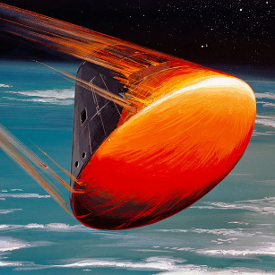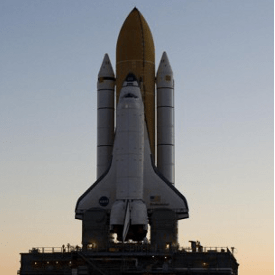
Hello, readers, and welcome to your Friday morning digest of space news from this week. If you’re looking for unalloyed good news, you’ve come to the right place. This week we’ve got astronauts of exceptional bravery, a tractor beam in a box, and a new way to clean up space junk. We’ll also hear from Perseverance and discuss a report that some asteroids might be more like “space cushions.”
SpaceX to Test Next-Gen Starlink Dish Designs
As part of its battle against congestion, SpaceX is testing out an upgrade for its Starlink user terminals. The company is looking at more than 200 designs, including mobile and stationary versions of the Starlink dish. The FCC recently granted SpaceX a license to test its new hardware for RF emissions — restricted to very specific locations. SpaceX will test its new terminals in five places, including Cape Canaveral, Redmond, and Mountain View.
Scientists Build Tiny Tractor Beam
Scientists from China recently built a tractor beam in a box and used it to move around a sliver of fancy graphene. Point the right kind of laser beam at an object, and even though photons are flowing away from the source, the beam pulls the object inward. It does this by heating the far side of the object, not the side the beam strikes. How? Blame physics.
NASA Names New Chief Astronaut
Thursday morning, NASA announced a new leader of its astronaut office. Former educator and three-time veteran of the International Space Station Joe Acaba will now serve as chief astronaut. Acaba takes the place of Drew Feustel, former acting chief of the office. Feustel has been at the post since NASA astronaut Reid Wiseman left late last year to rejoin the pool of astronauts eligible for flight assignments.
“Congratulations to Joe Acaba on being named the new chief of the astronaut office!” said NASA Administrator Bill Nelson in a Thursday statement. “Joe is an experienced space flyer and a proven leader, and he will undoubtedly inspire the next generation of NASA astronauts.”
“As we build on the International Space Station’s unparalleled success in low Earth orbit with our eyes on the moon and then Mars, Joe will play an integral role in ensuring our NASA astronauts are prepared for the challenges ahead,” Nelson said.
One such challenge: Maintaining the best possible working relationship with Russia and the cosmonauts aboard the ISS. However, Acaba takes office with some domain expertise, previously serving as director of NASA operations in Russia.
“Joe is an excellent leader who brings a wealth of experience to the Astronaut Office,” said NASA’s Director of Flight Operations Norm Knight, who selected Acaba for the role. “Knowing the significance of this position and the integrity of those who have previously served, I am confident Joe will be an outstanding chief for the Astronaut Office who will successfully lead our astronauts through an exciting future.”
Elsewhere at NASA…
…the agency chose a new landing site for Astrobotic’s lunar lander.
Under the aegis of the Artemis program, NASA’s Commercial Lunar Payload Services (CLPS) initiative works with American companies to get NASA payloads to the moon. For CLPS’ first flight, Astrobotic, a private aerospace and robotics company out of Pittsburgh, will launch its Peregrine lunar lander on a United Launch Alliance Vulcan Centaur rocket later in 2023. However, NASA and Astrobotic announced Thursday that they’ve changed their plan for where the lander will land.
Meet the new landing zone, functionally indistinguishable from the first featureless greyscale expanse of pockmarked terrain. This is where NASA intends for Astrobotic’s first lunar mission to land. (Credit: NASA)
In a blog post, NASA explained that they’re pretty sure they can do higher-value science if they move the landing site. So, they changed their target to a mare — an ancient hardened lava flow — on the northeast border of the Ocean of Storms, the largest dark spot on the Moon.
…two astronauts received medals of honor for bravery in space.
Vice President Kamala Harris awarded the Congressional Space Medal of Honor to former NASA astronauts Robert Behnken and Douglas Hurley at the agency’s Washington headquarters.
What do you think — would they pass the two beers and a puppy test? From left: Robert Behnken, Kamala Harris, Douglas Hurley. (Credit: NASA/Joel Kowsky, via NASA HQ Flickr)
Behnken and Hurley received the medal for their bravery during NASA’s SpaceX Demonstration Mission-2 to the International Space Station: the first crewed flight of the agency’s Commercial Crew Program.
…the agency is gearing up to launch more than a dozen people into orbit from US soil.
“We’re heading into, I would say one of the busiest increments in the history of Station,” said Kathy Lueders, NASA’s associate administrator for the Space Operations Mission Directorate, at a recent press conference. “We have a string of critical missions coming up.”
Those missions include three SpaceX launches and the first crewed flight of Boeing’s Starliner, putting fourteen people into orbit between them. Then there’s the replacement Soyuz that will carry home three astronauts semi-stranded aboard the International Space Station. And we can’t forget the resupply missions from SpaceX and Northrop Grumman, nor the one from Russia, that will launch from the Space Coast this spring. Busy indeed.
Webb Telescope Error Was Probably a Cosmic Ray
Have you ever had your otherwise stable computer reboot, out of the blue, for no reason whatsoever? Some one-off software glitches can result from a cosmic ray bit-flip error. This appears to be what happened to the James Webb Space Telescope. Software for Webb’s NIRISS instrument got stuck in a mystery failure loop last week, bringing the telescope’s flight software down with it. However, troubleshooting has revealed that the most likely culprit was a cosmic ray.
No harm came to NIRISS nor any other part of the telescope, and the JWST is back to its regular operating schedule. Helpdesk and tech support professionals can crow about this one: Ultimately, what the telescope needed was a reboot. Even space telescopes evidently need power cycling. Have you turned it off and back on again?
New ‘Drag Sail’ Helps Clear Space Junk
The European Space Agency has successfully tested a “braking sail” it intends to use to hasten the deorbit of space junk.
The ADEO (Drag Augmentation Deorbiting System) test model is a drag sail for space, designed to help de-orbit small satellites of 100 kg or less. It launched in late December 2022 by way of an ION satellite carrier. And what better way to try out a space junk clearing system than to clear the space junk from its own launch? ADEO unfolded its carbon-fiber booms and grabbed its carrier satellite, and just like a racecar’s drag chute, the whole shebang slowed right down. ESA engineers project that the sail will speed the carrier’s reentry into Earth’s atmosphere, shrinking the timeline by 75% or more.
“We want to establish a zero debris policy, which means if you bring a spacecraft into orbit, you have to remove it,” said Josef Aschbacher, ESA Director General.
Perseverance Completes Martian Sample Depot
Just shy of its second anniversary on Mars, NASA’s Perseverance rover has secured its legacy by completing its first sample cache on Mars. In addition to Martian rock and regolith, the cache contains a sample of Mars’ atmosphere. It also contains a “witness” tube, which analysts will use in the future to determine whether samples from Mars are contaminated with material from Earth.
“With the Three Forks depot in our rearview mirror, Perseverance is now headed up the delta,” said Rick Welch, Perseverance’s deputy project manager at JPL. “We’ll make our ascent via the ‘Hawksbill Gap’ route we previously explored. Once we pass the geologic unit the science team calls ‘Rocky Top,’ we will be in new territory and begin exploring the Delta Top.”
NASA Satellite Spots ‘Teddy Bear’ on Mars
Pareidolia is our word for how humans can see faces in clouds, huts on the moon, and the Virgin Mary on a piece of toast. Most recently, keen-eyed observers spotted a teddy bear in a most unlikely place: Mars. NASA’s Mars Reconnaissance Orbiter recently captured this image of a roly-poly teddy bear looking up out of the Martian terrain.
Get ready to bust out your 3D glasses: The University of Arizona has more in its original post, including a red-and-blue 3D image of the teddy bear’s home terrain.
‘Rubble Pile’ Asteroids Could Be Long-Lived ‘Space Cushions’: Report
Shortly before NASA’s DART spacecraft slammed into its target asteroid, Dimorphos, scientists realized it was more of a “rubble pile” than an icy rock. Astronomers and DART mission scientists were briefly concerned that instead of moving the asteroid, we’d blow it to smithereens. Instead, the asteroid tanked the impact like it was nothing, releasing just a puff of debris from the antipode of the crash. Now, a new article in PNAS has an explanation. The very rubble we thought would be Dimorphos’ fatal weakness might actually be the thing that kept it together.
The insight comes from a surprising source: Itokawa, the target of Japan’s Hayabusa asteroid probe. Study coauthor Fred Jourdan explains, “Unlike monolithic asteroids, Itokawa is not a single lump of rock but belongs to the rubble pile family, which means it’s entirely made of loose boulders and rocks, with almost half of it being empty space.” Where an “icy rock” asteroid might shatter in a collision, says Jourdan, rubble piles are more elastic and, therefore, more durable. The PNAS report shows that Itokawa is more than four billion years old and credits the asteroid’s structure for its longevity.
“The survival time of monolithic asteroids the size of Itokawa is predicted to be only several hundreds of thousands of years in the asteroid belt,” Jourdan said. “The huge impact that destroyed Itokawa’s monolithic parent asteroid and formed Itokawa happened at least 4.2 billion years ago. Such an astonishingly long survival time for an asteroid the size of Itokawa is attributed to the shock-absorbent nature of rubble pile material.”
“In short,” concluded Jourdan, “we found that Itokawa is like a giant space cushion and very hard to destroy.”
The First Stars May Have Weighed More Than 100,000 Suns
New simulations suggest that the early universe might have produced some stars of truly mind-boggling mass — the size of a supermassive black hole.
This image shows the Atacama Large Millimeter/submillimeter Array (ALMA) looking up at the Milky Way. Inset: Sagittarius A*, the supermassive black hole at the center of our galaxy. (Credit: ALMA/ESO/EHT)
After the Big Bang, once the universe had cooled down enough, primordial matter began to coalesce into supermassive black holes and the elusive Population III stars. But hot gas and plasma don’t always cooperate with gravity because warmer material fights to expand, preventing itself from collapsing. So how did things start to come together? For a more thorough explanation, a team of Japanese astronomers ran simulations of a phenomenon known as cold accretion.
Space is huge. Even so, from time to time, things like accretion discs and clouds of cold, dense matter can run smack into one another. When that happens, in lieu of a splash, a shockwave forms. Just as physical shock can precipitate crystals out of a saturated solution in a beaker, the new simulations suggest, that gigantic shockwave triggers the instant “nucleation” of some of the cold, dense matter involved in the collision. This starts a gravitational cascade, forming gigantic supermassive stars of up to 100,000 solar masses.
Some large gas giants are called “failed stars” because they have enough mass to be stars, but their cores can’t sustain fusion. Likewise, the simulations suggest, the largest supermassive stars may have been on the cusp of becoming supermassive black holes. The astronomers hope that future observations on the JWST will provide more clues.
Skywatchers Corner
Sunday night into Monday, the waxing Moon reaches its full phase. All month, the Moon will hang out near Jupiter and Venus in the western sky after sunset. The three celestial bodies will drift closer together in the sky each night until Venus and Jupiter reach conjunction on March 1.
Thursday night, Comet C/2022 E3 (ZTF) made its closest approach to Earth. This long-period comet was last visible from Earth in the time of the Neanderthals. Alas, it will soon be time to say goodbye to our pea-green celestial visitor. The comet is heading back into the outer reaches of the solar system — probably for good.
To catch a glimpse of the departing comet and its twin tails, you’ll want at least a pair of binoculars. Look toward the celestial north pole shortly before midnight.
Source: This Week in Space: Drag Sails, Cosmic Rays, and ‘Space Cushions’


















Recent Comments